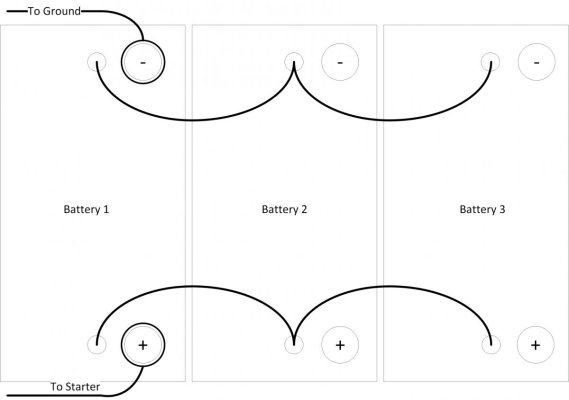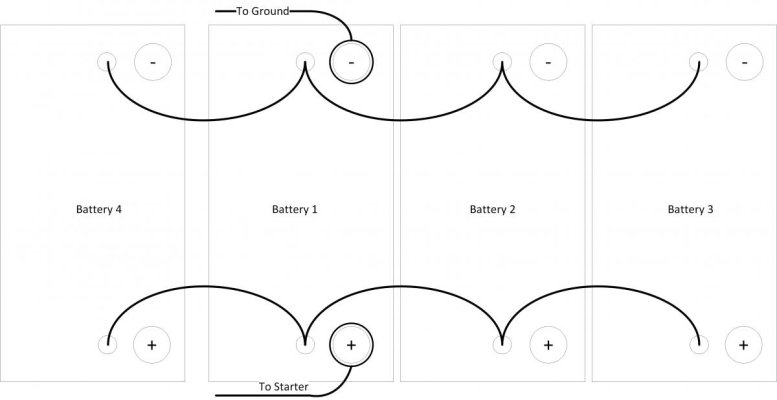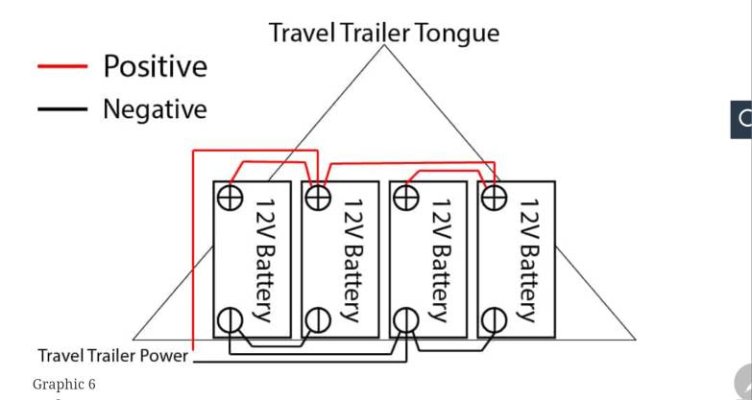BDofMSP
Guru
- Joined
- Sep 5, 2013
- Messages
- 905
- Location
- USA
- Vessel Name
- Gopher Broke
- Vessel Make
- Silverton 410 Sport Bridge
Hello. Been a long time since I posted - I hope I'm still welcome!
This year I replaced both of my battery banks. Each bank was three G31 FLAs which performed both house and start duties. When I replaced them I added a fourth battery to each bank.
The original configuration of each bank was as attached, with the positive and negative cables connected to Battery 1. I have been told (here) that it's better to balance the bank by having one cable (e.g. starter) on Battery 1 and the other (e.g. ground) on Battery 3, and I was able do to that on the Port bank when I bought the boat. On the starboard, it would have required replacing a cable, and I never bothered.
However now that I just replaced the bank, I'd like to take good care of it. On the Port bank I was able to add the 4th battery outboard of Battery 3, and move the ground to it, so it remains balanced. But on the Starboard I had to put Battery 4 outboard of Battery one, which has the starter and ground connected to it. See attached.
So, while I don't mind replacing the ground cable, it's not high on my list right now vs other projects. My question is, how concerned should I be about this somewhat janky configuration? Can it wait until winter with little impact? Or is it a larger deal than I'm giving it credit for?
Ironically, it was the port bank (which was balanced) that gave out and drove the replacement in the first place. Of course they each have different loads and usage so that's not necessarily very telling, but it didn't seem to have any big negative impact on the starboard bank.
Thanks for any feedback.
BD
This year I replaced both of my battery banks. Each bank was three G31 FLAs which performed both house and start duties. When I replaced them I added a fourth battery to each bank.
The original configuration of each bank was as attached, with the positive and negative cables connected to Battery 1. I have been told (here) that it's better to balance the bank by having one cable (e.g. starter) on Battery 1 and the other (e.g. ground) on Battery 3, and I was able do to that on the Port bank when I bought the boat. On the starboard, it would have required replacing a cable, and I never bothered.
However now that I just replaced the bank, I'd like to take good care of it. On the Port bank I was able to add the 4th battery outboard of Battery 3, and move the ground to it, so it remains balanced. But on the Starboard I had to put Battery 4 outboard of Battery one, which has the starter and ground connected to it. See attached.
So, while I don't mind replacing the ground cable, it's not high on my list right now vs other projects. My question is, how concerned should I be about this somewhat janky configuration? Can it wait until winter with little impact? Or is it a larger deal than I'm giving it credit for?
Ironically, it was the port bank (which was balanced) that gave out and drove the replacement in the first place. Of course they each have different loads and usage so that's not necessarily very telling, but it didn't seem to have any big negative impact on the starboard bank.
Thanks for any feedback.
BD



